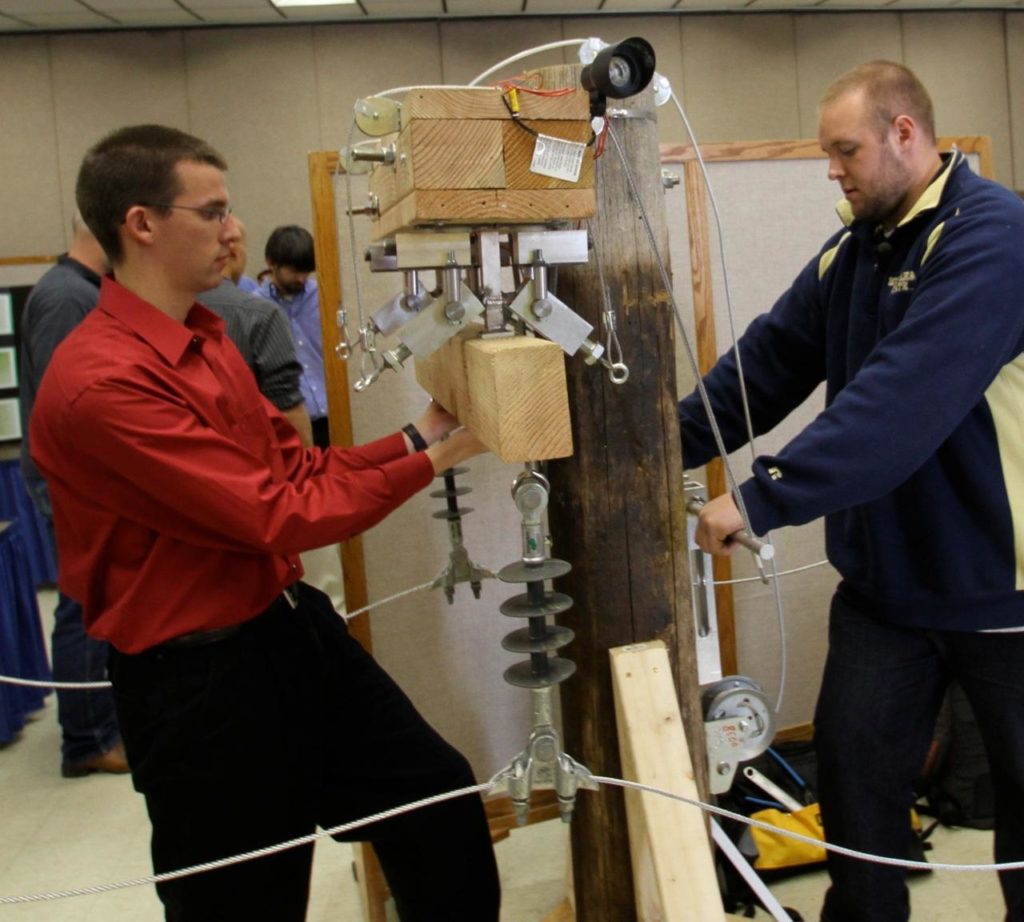If a Montana inventor and some of the state’s brightest engineering students are correct, there may finally be a solution to the Achilles’ heel of North America’s vital electrical grid, the wooden power pole. At an event Thursday at Montana State University in Bozeman a trio of MSU Seniors displayed their intriguing final project, a working prototype of inventor Dennis Bell’s Grid Defender® power line support system.
Bell’s patented invention replaces the fixed cross-arm on a power pole with a bar that can descend to the ground, either because of weight on the lines or on command. This feature could provide a solution to the major part of a problem that costs American consumers $79 billion dollars a year. Power outages, caused by broken wooden poles, are the leading reason the power grid fails, a stark fact that has not changed in over a century.
An example of the magnitude of this dilemma lies in neighboring North Dakota where earlier this month over 500 miles of distribution line, and more than 20,000 wooden poles, literally snapped and fell to the ground after a snow storm. Many customers are still without power and the damage from this single storm is expected to top $100 million, ultimately paid for by consumers.
Bell’s patented cross-arm system is a radical departure from the fixed “T” design that has been used to support aerial lines since his distant relative Alexander Graham Bell first strung phone lines almost 150 years ago. Moveable cross-arms allow poles to be set and distribution lines to be strung while the cross-arms are on the ground and then raised into place. This patented “ground up” approach could save up to 80% of the time it takes to build lines now. And that is only one of the concept’s significant benefits. Once mounted each “smart” cross-arm housing becomes part of a controlled sector than can be activated from the ground or remotely from a central station. In the event of a threat, such as an approaching hurricane or a winter storm such as whacked rural North Dakota, the power can be shutoff to a sector and the lines lowered until the threat has passed.
“By using a moveable cross-arm the Grid Defender® system promises to be much faster to build, cheaper to maintain and much safer to operate than traditional power line support systems”, said Jeff Hansen, one of the MSU Engineering Seniors who volunteered to research the system as part of their final grade before graduation. “We really enjoyed working on this idea because it has such enormous potential for protecting power lines. All these ‘Smart Grid’ ideas aren’t very smart if it keeps falling down.”
Traditional support systems elevate power lines to a fixed position above ground, requiring aerial equipment to construct and maintain. These lines, exposed to hurricane winds and ice storms, can act like a sail exerting tremendous pressure where the pole enters the ground. Worse still, when one pole snaps, it can create a domino effect that pulls poles down on either side of itself. As the recent storm in North Dakota demonstrates these “dominoes” can fall for hundreds of miles, leaving homebound consumers and businesses without power indefinitely as new poles, crews and equipment from neighboring states arrive to literally rebuild the system.
The Grid Defender® was one of a number of Capstone Projects on display Thursday in the MSU Student Union Ballroom, part of an annual effort by MSU’s highly respected Engineering Department to give students hand-on experience with real world concepts. Of dozens of ideas submitted to the school for Capstone consideration the Grid Defender® was the most popular among the students and three Seniors; Hansen, Jeremy Hargis and Bryan Goss were chosen to work on the utility idea.
The trio demonstrated the prototype they created after working with Bell and incorporating their own ideas and those of consulting MSU Engineering faculty.
“It’s an impressive idea,” said Robb Larson the engineering professor who coordinates the popular Capstone Program. “There is enormous attention being paid to the power grid today but this is only concept I know of that addresses the main reason for power outages and that is the failure of wooden support poles.”
Student Bryan Goss was surprised at how little research has been done by the utility industry on solving what has been the leading cause of power failure since the industry first sold electricity. “I call it a ‘hopeless mentality’ because we could not see where alternatives to fixed aerial lines have ever gotten much attention,” said Goss “I hope our work helps to open some eyes out there. “
Engineering Senior Hargis also found the work interesting and commented on the wide range of applications the technology could fulfill. “My wife comes from rural Montana and you realize how exposed folks in farming and ranching country are to power failure. They lost over 20,000 poles this month in the Dakotas and it barely made the national news. These storms wreck so many lives but the power outages are taken as business as usual. And that is just where ice is concerned. When you think of getting lines out of the way of hurricanes you have another huge area of the country that could benefit.”
The prototype the students built over their seven month Capstone effort was on display in the huge ballroom with other student projects. It is the student’s own version of Bell’s core concept which is to create a moveable cross arm with manual or remote activation.
“Our model here shows how this could be a retrofit on an existing power pole but the final systems won’t necessarily look like this,” said Senior Hansen, a straight “A” student who in his other college role captained the MSU football team and is on his way to play for the San Diego Chargers after graduation. “Once a final design is determined the use of injection molded plastic parts will make this very inexpensive to mass produce. For power companies it could be so much faster and thus less costly to erect I think they will be able to cost-justify it even if they never lower the lines to avoid a disastrous weather event.”
“I’m really pleased with the effort these young men have put in,” said Bell who visited with the students following their graded presentation to Capstone faculty. “They’ve taken my initial concept and added several interesting features. This is an important phase of development because the more engineering minds who vet the idea the more solid our approach becomes.”
Inventor Bell has some 30 patents to his name, the majority of which are still in production. He retired to Montana but enjoyed working with the MSU students to perfect the Grid Defender®, an invention he has been toying with for over a quarter century.
“Working with students and faculty is great because they provide a peer review of my concepts”, said Bell. “MSU has a great engineering department and I’m looking forward to continuing to work with them on larger prototypes and in getting this idea in front of utilities that can benefit from this new support system.”
— 30 —




